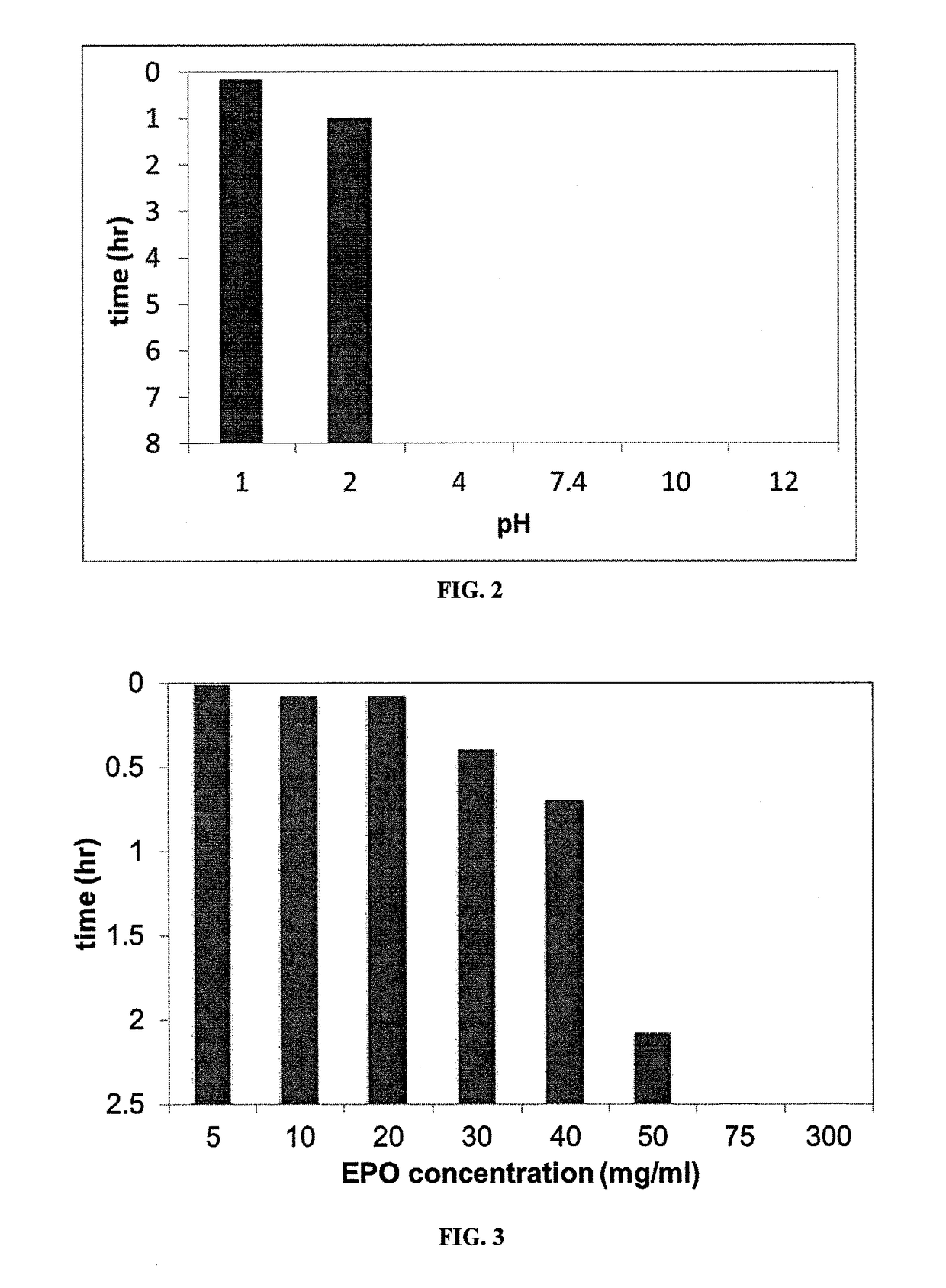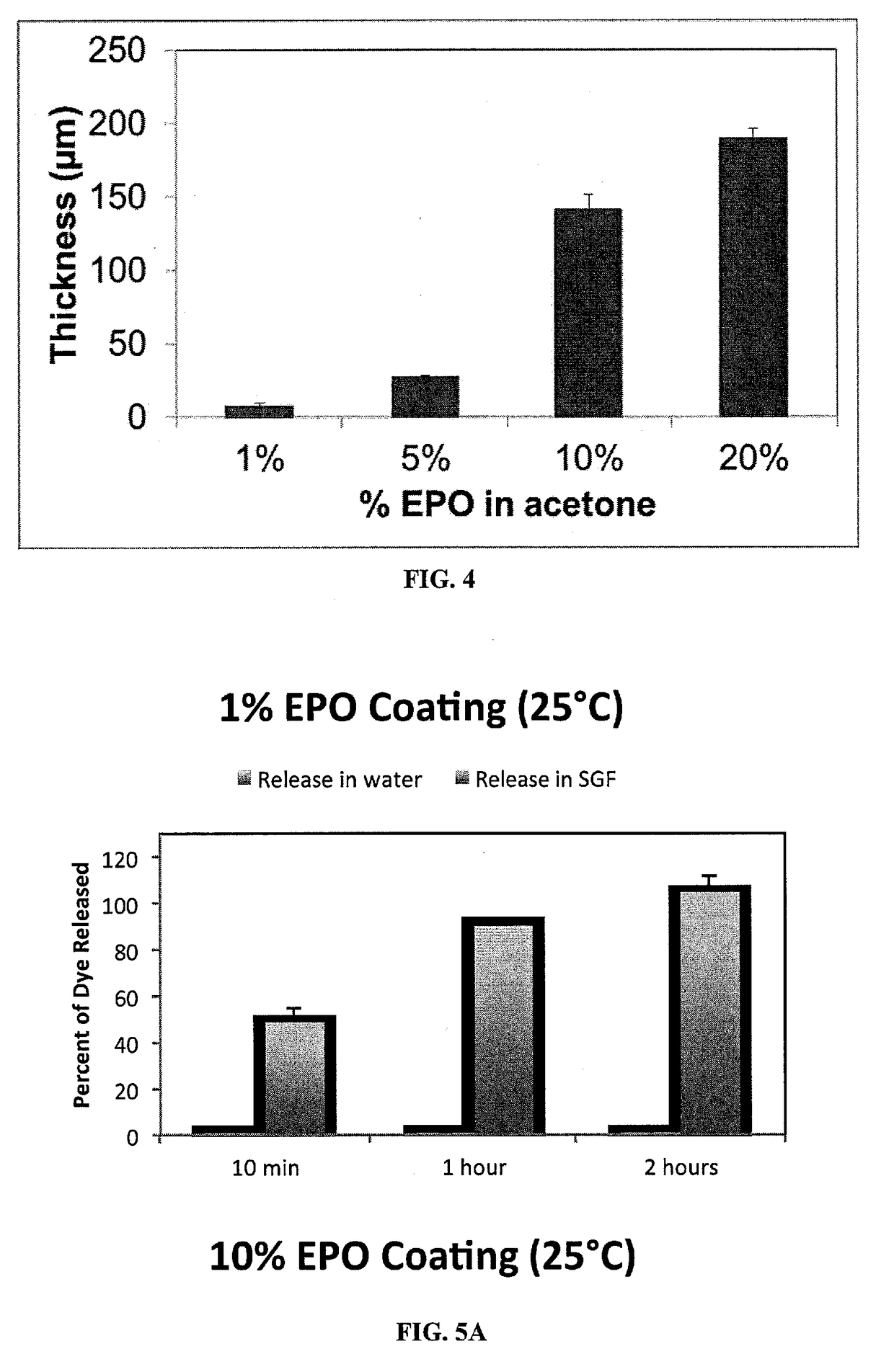Fortified micronutrient salt formulations
a technology of micronutrients and formulations, applied in the field of fortified salts, can solve the problems of supplementation limitations, malnutrition/micronutrient deficiency, and five million child deaths each year, and achieve the effects of reducing the number of children, uniform color, and efficient encapsulation of mns
- Summary
- Abstract
- Description
- Claims
- Application Information
AI Technical Summary
Benefits of technology
Problems solved by technology
Method used
Image
Examples
example 1
Polymer Solubility Studies
[0125]Methods and Materials
[0126]The solubility of the commercially available polymer dimethylaminoethyl methacrylate, butyl methacrylate, and methyl methacrylate (2:1:1 ratio) (EUDRAGIT® E PO (“EPO”)) at pH from 1-12 was evaluated. 10 mg / ml of the polymer was added to solutions having a pH of 1 2, 4, 7.4, 10, and 12 and observed over 8 hours.
[0127]EUDRAGIT® E PO was dissolved in simulated gastric fluid (SGF) at 37° C. at various concentrations over 2.5 hours to determine the solubility limit in simulated gastric fluid.
[0128]Results
[0129]The pH-dependent solubility is shown in FIG. 2. In a two-hour period, the polymer is dissolved at pH 2 and below. The polymer was insoluble at pH 4, 7.4, 10, and 12.
[0130]The dissolution in simulated gastric fluid (“SGF”) is shown in FIG. 3. EPO has a maximum solubility of 50 mg / mL. Given the volume of the stomach is 20-100 mL, 1-5 g of EPO can be delivered to the stomach and still retain full dissolution.
example 2
Dye Release Studies of Crystallized Dye / Sugar Mixtures Coated with EUDRAGIT® E PO
[0131]Materials and Methods
[0132]0.6 mL of a sugar / dye solution (0.5 M trehalose+sucrose) was crystallized in a beaker. The crystallized mixture was coated with 1 mL of a EUDRAGIT® E PO (“EPO”) solution in acetone (1%, 5%, 10%, and 20%). The EPO film thickness was imaged and measured.
[0133]The release kinetics were studied in water and SGF (release volume of 4 mL) over a period of two hours. Time points were taken at 10 min, 1 hr, and 2 hr, and the dye release was quantified by absorbance measurement at 628 nm.
[0134]Using the 5% EPO coating, the release was tested at different temperatures.
[0135]Results
[0136]The film thickness results are shown in FIG. 4. At 1% EPO, the coating thickness was about 5 microns while at 20% EPO, the coating thickness was about 200 microns. Varying the concentration of the polymer varies the coating thickness. Any volatile organic solvents can be used to dissolve the polymer...
example 3
Release Studies of EUDRAGIT® E PO-Coated Micronutrients
[0139]Materials and Methods
[0140]0.6 mL of nutrient / sugar solutions (1:1 ratio) were crystallized and coated with a 5% (by weight) solution of EUDRAGIT® E PO (“EPO”) in acetone.
[0141]To mimic food preparation then ingestion, the samples were submerged in 4 mL water (at 25° C. or 100° C.) for one hour and transferred to 4 mL simulated gastric fluid at 37° C. for two hours. Aliquots were taken at 1, 2, and 3 hours, and the release was quantified using ELISA.
[0142]Results
[0143]The results are shown in FIGS. 7A and 8A (one hour at room temperature, then body temperature) and 7B and 8B (one hour at boiling water temperature, then body temperature). For Vitamin B9 (FIGS. 7A and 7B) and B12 (FIGS. 8A and 8B), there was negligible release in water at both 25° C. and 100° C. and near complete release after one hour in SGF.
PUM
| Property | Measurement | Unit |
|---|---|---|
| temperature | aaaaa | aaaaa |
| solubility | aaaaa | aaaaa |
| temperature | aaaaa | aaaaa |
Abstract
Description
Claims
Application Information
 Login to View More
Login to View More - R&D
- Intellectual Property
- Life Sciences
- Materials
- Tech Scout
- Unparalleled Data Quality
- Higher Quality Content
- 60% Fewer Hallucinations
Browse by: Latest US Patents, China's latest patents, Technical Efficacy Thesaurus, Application Domain, Technology Topic, Popular Technical Reports.
© 2025 PatSnap. All rights reserved.Legal|Privacy policy|Modern Slavery Act Transparency Statement|Sitemap|About US| Contact US: help@patsnap.com



